At their simplest, telegraphs are pretty simple indeed. They've long been the subject of workshop construction projects. Here, I'll list, link to, or in some cases reprint a few of those projects which I find most interesting. However, I'll mostly omit:
On searching: Naturally, in the 21st century, the best place to search for telegraph projects is the web. Not everything shows up there, though. I've found it useful as well to search through the collections of digitized literature using Google Books, the Internet Archive, and the Hathi Trust. Additionally, and especially for guidance on "freelance" projects, I've found it useful to search for pictures of apparatus on photo sharing sites (e.g., flickr), via web image searches (Google: images), and in online video (such as youtube). Lindsay Publications also tends to carry a couple of good books on electromagnets and coil winding. In other words, as was said in Casablanca, "round up the usual suspects."
There have been more projects published than one might expect (even excluding modern kits). For a quick look, in my opinion the article by Hamilton (1918) is the best for a relatively complex set of traditional appearance, Prof. Perera's Simple Telegraph is probably the best modern project using simple techniques, and the slide presentation by the Univ. of IL Extension, McLean is good if you need step-by-step photographs. Of course, the others all have their various virtues as well.
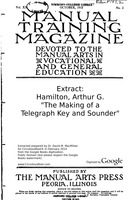
Hamilton (1918)
Hamilton, Arthur G. "The Making of a Telegraph Key and Sounder." Manual Training Magazine. Vol. 20, No. 2 (October 1918). (Peoria, IL: The Manual Arts Press, 1918): 44-51 (pp. 98-105 of the Google books PDF of the whole volume). This is the best construction article I've found for a sounder and key of traditional appearance. It includes dimensioned drawings. This is an extract of the Hamilton article from the Google Books PDF of the entire volume.
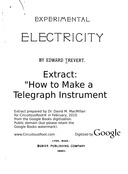
Trevert (1890)
Trevert, Edward. "How to Make a Telegraph Instrument," [chatper VII of his] Experimental Electricity. (Lynn, MA: Bubier Publishing Company, 1890.) pp. 89-95. This project includs measured drawings, though they are not as elaborate as the ones in Hamilton, above. Note that the Morse Code given on p. 95 is the American, not the International code. This is an extract of Chapter VII from the Google Books PDF of the entire volume.

Tom Perera, W1TP (Simple Telegraph)
"How to Build Simple Telegraph Sets," by Prof. Tom Perera (W1TP), Ph.D. This is about as simple as it gets (wood, wire, and bent metal strips), but it is well presented. It is online at http://www.w1tp.com/build.htm, a part of Prof. Perera's excellent W1TP Telegraph and Scientific Instrument Museums.

Tom Perera, W1TP (Camelback Key)
Prof. Perera has also drawn measured plans for a US Civil War era "Camelback" style telegraph key. These are online at the Telegraph Museum Inventory, http://www.w1tp.com/perkcol.htm (search down the page for "Construction Plans for a Phelps Camelback Key") a part of his W1TP Telegraph and Scientific Instrument Museums.

The Steampunk Workshop (2007, Sounder Only)
This is by Jake von Slatt (a nom de steel-nib plume), so naturally it has more class than other projects. He has a nice video on coil winding. Other than that, though, it's a bit short on details - it's more of an inspiration than a how-to (and indeed it was inspirational to me). He's also done a nice "Airship Duty" future-that-never-was version in aluminum. As Tom Lehrer said, it's people like that who make you realize how little you've accomplished. This is online as Telegraph Clacks out RSS Feeds within Mr. Von Slatt's inimitable Steampunk Workshop.

Cook (1954)
Cook, Sherman R. Electrical Things Boys Like to Make. (Milwaukee, WI: The Bruce Publishing Company, 1954). This is one of the better amateur project books the I've seen. Measured drawings, good explanations, and sections on procedures and components. Of course, he also has a truly alarming Electric Weiner Cooker, but that's not in the Telegraph section!
There was also at least one earlier edition, and there have been later reprints. The 1954 edition was reprinted in 2005 by Lindsay Publications, and as of 2010 it is still available from them.

UI Extension, McLean
The University of Illinois Extension, McLean County (apparently with its 4-H program), has a PowerPoint (format) presentation on "How to Make a Telegraph: Exploring the Magic of Electricity" It is online at: web.extension.illinois.edu/mclean/downloads/509.ppt . It's basically a series of annotated photographs. Generally photographs are not nearly as good a means of illustrating technical work as drawings or engravings, but these are pretty good. The project looks to be admirably crude but effective.
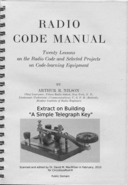
Nilson (1942, Key Only)
Nilson, Arthur Reinhold. "A Simple Telegraph Key," [a section in his] Radio Code Manual: Twenty Lessons on the Radio-Code and Selected Projects on Code-Learning Eqipment . (NY: McGraw-Hill Book Company, 1942.) This contains an interesting suggestion for obtaining durable contact points for keys: use automotive points. While these are less common now than they were in 1942, they are still available. The key described is intended for radio use and therefore does not have a circuit closer; adding one is, however, simply a matter of putting a switch in the line. The icon/link here is to an extract of just this section, from a scan done by me of the original. Most of the pages in this PDF have been reduced in size and converted to JPEGs. The photograph of the key and the drawings for it have been retained as PNG images at full 600dpi scanning resolution, however. (The rest of the chapter on "How to Build Code Practice Apparatus" involves equipment intended for radio telegraphy and CW. The book in general is primarily a code training manual for radio telegraph operators.)
The section on building "A Simple Telegraph Key" also has been reprinted online on the blog of Simone (IW5EDI).

Unknown & Channe (Sounder Only)
This is a modern web version reworked and expanded from an unspecified article in "a science encyclopedia." It is online as How to Build a Telegraph Sounder on Alvenh Channe's website.
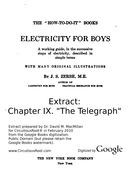
Zerbe (1914)
Zerbe, James Slough. Electricity for Boys. (NY: The New York Book Company, 1914): 90-97. This is supposed to be a construction project, but the drawings presented are really very sketchy. They would be useful for suggesting simplified versions of the apparatus. This is an extract of Chapter IX from the Google Books PDF of the entire volume.
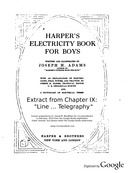
Adams (1907)
Adams, Joseph H. Harper's Electricity Book for Boys. (NY: Harper and Brothers, Publishers, 1907). The sounder described has only one stop; I haven't built it, but I presume that it depends upon the sound of the crossbar hitting the electromagnet for the "down" stroke. I'm not sure that I'd choose it as the unit upon which to learn to hear the code on a sounder. This book is available online via Google Books. The link here is to an extract of the relevant parts of "A Ground Telegraph" (less the Young Edison story) from the Google Books PDF of the entire volume.
This book was also reprinted in 1998 by Lindsay Publications, but I don't presently (2010) see it listed as available.

Draper (1902?)
Draper, Frederick A. "Telegraph Instruments," in Amateur Work Magazine. Vol. 1 (Draper Publishing Co., 1902? [Google Books indicates that Vol. 1 was 1881]). It's a pretty spare description.
Extracts from this magazine, reformatted, have been republished on the Chest of Books site. It seems also to have been republished in 2007 by Kessinger Publishing, LLC (ISBN-13: 978-0548415009). Google Books has scanned the originals, but not yet (2010) released them.

Popular Mechanics / Science
So far, I've found that the telegraph-specific items I've discovered in Popular Mechanics (and as collected in various editions of The Boy Mechanic) and Popular Science have been too cursory to be useful. For coil winding and electromagnet making, however, this is not the case (see below).
(Of course these are only a few pointers to a vast literature.)

Popular Mechanics (1935), Electromagnets
Crowley, C. A. "Designing and Building Electromagnets." Popular Mechanics. Vol. 64, No. 3 (September, 1934): 470-476. Beautifully presented. Online on Google Books.

Popular Science (1921), Coil Winding
Parker, H. H. "Coil-Winding Suggestions for the Amateur." Popular Science Monthly. (August, 1921): 82. Online on Google Books.
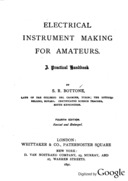
Bottone
Bottone, S. R. Electrical Instrument Making for Amateurs. The icon here links to a local copy of the Google Books digization (4th edition (1891)). This is an intereating project book in general, covering not only projects but methods. It looks more toward the 18th and very early 19th century and electrostatics, however. (I sincerly hope that nobody now tries to use his "medical coil" for medical purposes! Some aspects of the 19th century are in fact better left in the past.) Bottone doesn't cover telegraphs specifically, but he has very good material on suitable electromagnets. In the 2nd ed. (1888) and 4th ed. (1891) see especially pp. 81-90 (coil winding). See also the "Appendix to [section 74] Dynamo" concerning Electro-Magnets (2nd ed. (1888) pp. 178-180; 4th ed. (1891) 197-199).
The second edition (1888) was also reprinted in 1988 by Lindsay Publications, but I don't presently (2010) see it listed as available; I'm glad I got my copy when I did.
The patent literature isn't as useful a source for telegraph designs as one might thing, for a couple of reasons. First, the most interesting component, the sounder, wasn't invented at all. It arose accidentally out of the observation of the operation of earlier telegraph registers. Second, as usual the bulk of the patent literature records wishful thinking in great detail. Still, a few patents are useful both for their own descriptions and (sometimes incidentally) for their illustrations.
159,894, Bunnell
Bunnell, Jesse H. US patent 159,894. Filed 1874-07-31. Issued 1875-02-16. "Improvement in Telegraph Sounders." This is the characteristic sounding arch of Bunnell's (and many later) sounders. The PDF here is one that I prepared from the official digitizations from the USPTO.
237,808, Bunnell
Bunnell, Jesse H. US patent 237,808. Filed 1880-10-15. Issued 1881-02-15. "Telegraphic Key." One-piece construction of the key lever. The PDF here is one that I prepared from the official digitizations from the USPTO.
A tiny subset, but (a) good, and (b) more appropriate to the tinkerer than modern electrical engineering textbooks. See also Cook (1954) as a particularly good general electrical project book.
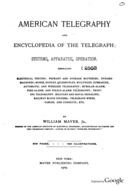
Maver
Maver, William, Jr. American Telegraphy and Encyclopedia of the Telegraph: Systems, Apparatus, Operation . The 4th edition (NY: Maver Publishing Co., 1909) is online at Google Books. (The icon here links to a local copy of that digitization.)
The 5th edition (1912) has been reprinted by Lindsay Publications and is currently (2010) listed on his website as available.
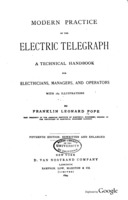
Pope
Pope, Franklin Leonard. Modern Practice of the Electric Telegraph: A Technical Handbook for Electricians, Managers, and Operators . (NY: D. Van Nostrand Company, 1899.) The link here is to a local copy of the Google Books digitization. See p. 50 (PDF 75) for illustrations of Binding Screws (terminals), p. 91 (PDF 116) for "Construction of Telegraph Magnets," and p. 138 (PDF 163) for "Equipment of American Telegraph Lines" (these are some of the better contemporary illustrations of keys, sounders, and relays).
All portions of this document not noted otherwise are Copyright © 2010 by David M. MacMillan and Rollande Krandall.
Circuitous Root is a Registered Trademark of David M. MacMillan and Rollande Krandall.
This work is licensed under the Creative Commons "Attribution - ShareAlike" license. See http://creativecommons.org/licenses/by-sa/3.0/ for its terms.
Presented originally by Circuitous Root®
Select Resolution: 0 [other resolutions temporarily disabled due to lack of disk space]